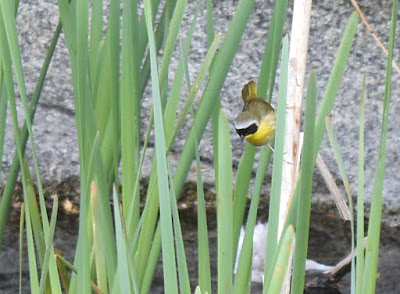Birds of prey make a fascinating presence at Halibut Point.
If you get a good look ‒
generally at one that's perched ‒
the talons, hooked beak, and penetrating stare tell the story of the raptor's
lifestyle and why it's liable to be mobbed by other birds upon discovery. Their
raucous harassment may be the first you know of the raptor's presence.
More
often you'll see raptors in the air, where specific identification can be
difficult. You might get only a glimpse of a large fast-moving bird zipping by
at treetop level. Or you may notice a faraway speck circling in the sky. Right
now the raptors migrating past this area give us one of our best chances for an
admiring look. There are many plumages, postures, and age-groups to sort
through in making a positive raptor identification. Your sighting will fall into one of these groups.
BUTEOS
 |
| Adult Red-tailed Hawk |
The Red-tailed Hawk, seen occasionally as a roadside
sentinel in a tree or utility pole, is our most common local raptor. Its chunky proportions and relatively
short-tail are characteristic features of buteos.
 |
| Juvenile Red-tailed Hawk |
This juvenile has not yet taken on its mature plumage and
eponymous tail coloration. It circles over open areas using long rounded wings
and widely spread wide tail feathers to support its lofty soaring on the lookout for small mammal prey far below.
Pictured below are two other buteos overflying Halibut Point. In migration they search out thermal updrafts to gain altitude and glide down forward to the next one on their
route, occasionally using spare wing beats.
 |
| Broad-winged Hawk |
 |
| Red-shouldered Hawk |
 |
| Immature Bald Eagle |
Based on anatomical proportions and hunting habits Bald
Eagles can be thought of as dark-colored oversized buteos. Adults are distinguished by their white heads and tails. In
flight eagles hold their wings level and steady unlike vultures, the other
large dark birds, that tilt in flight with wings paired conspicuously in a
V-shaped dihedron, and are not adapted to the pursuit of live prey.
ACCIPITERS
 |
| Cooper's Hawk |
Accipiters chase small birds and mammals through shrubbery
and forested areas. Their relatively short wings and long tail give them exceptional
maneuverability. In flight they can often be distinguished by a series of
short, rapid flaps followed by a glide.
 |
| Cooper's Hawk |
Cooper's Hawk, the most common local accipiter, is a crow-sized
bird with a conspicuously striped tail. The Sharp-shinned Hawk that closely
resembles it is the size of a Blue Jay.
HARRIER
 |
| Northern Harrier |
Northern Harriers look for prey from stationery perches such
as fence posts, or on the wing by circling low over open country, especially
marshes. Thus they are infrequently encountered on the moors and woodlands of
Halibut Point. Long tails and pointed
wings enable them to pounce quickly on prey during their low altitude sallies. A
prominent white patch above the tail and wings held in a dihedral distinguish Harriers
from other raptors.
FALCONS
Falcons use their slender, pointed wings
to pursue other birds in wide open spaces. They
patrol with steady flapping before sudden acceleration when giving chase.
 |
| Merlin |
The Blue Jay-sized Merlin
may also hunt from a stationery perch. It closes on its prey with powerful,
piston-like wing beats.
 |
| Peregrine Falcon |
This Peregrine Falcon found thermals last week to soar almost stationery in the air rising above
Halibut Point. Sometimes they ride these updrafts to great heights, tuck
in their pointy wings and plunge with terrific speed on unsuspecting victims.
* * *
.jpg) |
| Red-tailed Hawk with prey in talons |
Raptors in their various sizes, shapes, and skills
illustrate the marvel of diverse niche adaptations in the natural world.













































.jpg)